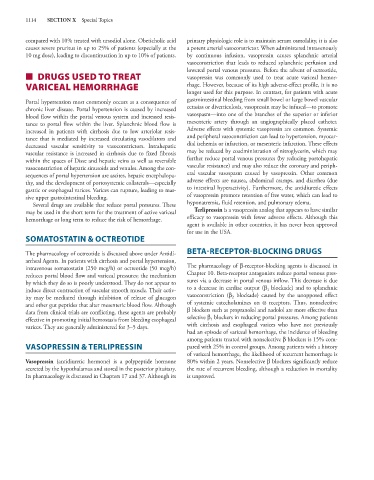Page 1128 - Basic _ Clinical Pharmacology ( PDFDrive )
P. 1128
1114 SECTION X Special Topics
compared with 10% treated with ursodiol alone. Obeticholic acid primary physiologic role is to maintain serum osmolality, it is also
causes severe pruritus in up to 25% of patients (especially at the a potent arterial vasoconstrictor. When administered intravenously
10 mg dose), leading to discontinuation in up to 10% of patients. by continuous infusion, vasopressin causes splanchnic arterial
vasoconstriction that leads to reduced splanchnic perfusion and
lowered portal venous pressures. Before the advent of octreotide,
■ DRUGS USED TO TREAT vasopressin was commonly used to treat acute variceal hemor-
VARICEAL HEMORRHAGE rhage. However, because of its high adverse-effect profile, it is no
longer used for this purpose. In contrast, for patients with acute
Portal hypertension most commonly occurs as a consequence of gastrointestinal bleeding from small bowel or large bowel vascular
chronic liver disease. Portal hypertension is caused by increased ectasias or diverticulosis, vasopressin may be infused—to promote
blood flow within the portal venous system and increased resis- vasospasm—into one of the branches of the superior or inferior
tance to portal flow within the liver. Splanchnic blood flow is mesenteric artery through an angiographically placed catheter.
increased in patients with cirrhosis due to low arteriolar resis- Adverse effects with systemic vasopressin are common. Systemic
tance that is mediated by increased circulating vasodilators and and peripheral vasoconstriction can lead to hypertension, myocar-
decreased vascular sensitivity to vasoconstrictors. Intrahepatic dial ischemia or infarction, or mesenteric infarction. These effects
vascular resistance is increased in cirrhosis due to fixed fibrosis may be reduced by coadministration of nitroglycerin, which may
within the spaces of Disse and hepatic veins as well as reversible further reduce portal venous pressures (by reducing portohepatic
vasoconstriction of hepatic sinusoids and venules. Among the con- vascular resistance) and may also reduce the coronary and periph-
sequences of portal hypertension are ascites, hepatic encephalopa- eral vascular vasospasm caused by vasopressin. Other common
thy, and the development of portosystemic collaterals—especially adverse effects are nausea, abdominal cramps, and diarrhea (due
gastric or esophageal varices. Varices can rupture, leading to mas- to intestinal hyperactivity). Furthermore, the antidiuretic effects
sive upper gastrointestinal bleeding. of vasopressin promote retention of free water, which can lead to
Several drugs are available that reduce portal pressures. These hyponatremia, fluid retention, and pulmonary edema.
may be used in the short term for the treatment of active variceal Terlipressin is a vasopressin analog that appears to have similar
hemorrhage or long term to reduce the risk of hemorrhage. efficacy to vasopressin with fewer adverse effects. Although this
agent is available in other countries, it has never been approved
for use in the USA.
SOMATOSTATIN & OCTREOTIDE
The pharmacology of octreotide is discussed above under Antidi- BETA-RECEPTOR-BLOCKING DRUGS
arrheal Agents. In patients with cirrhosis and portal hypertension,
intravenous somatostatin (250 mcg/h) or octreotide (50 mcg/h) The pharmacology of β-receptor-blocking agents is discussed in
reduces portal blood flow and variceal pressures; the mechanism Chapter 10. Beta-receptor antagonists reduce portal venous pres-
by which they do so is poorly understood. They do not appear to sures via a decrease in portal venous inflow. This decrease is due
induce direct contraction of vascular smooth muscle. Their activ- to a decrease in cardiac output (β blockade) and to splanchnic
1
ity may be mediated through inhibition of release of glucagon vasoconstriction (β blockade) caused by the unopposed effect
2
and other gut peptides that alter mesenteric blood flow. Although of systemic catecholamines on α receptors. Thus, nonselective
data from clinical trials are conflicting, these agents are probably β blockers such as propranolol and nadolol are more effective than
effective in promoting initial hemostasis from bleeding esophageal selective β blockers in reducing portal pressures. Among patients
1
varices. They are generally administered for 3–5 days. with cirrhosis and esophageal varices who have not previously
had an episode of variceal hemorrhage, the incidence of bleeding
among patients treated with nonselective β blockers is 15% com-
VASOPRESSIN & TERLIPRESSIN pared with 25% in control groups. Among patients with a history
of variceal hemorrhage, the likelihood of recurrent hemorrhage is
Vasopressin (antidiuretic hormone) is a polypeptide hormone 80% within 2 years. Nonselective β blockers significantly reduce
secreted by the hypothalamus and stored in the posterior pituitary. the rate of recurrent bleeding, although a reduction in mortality
Its pharmacology is discussed in Chapters 17 and 37. Although its is unproved.

